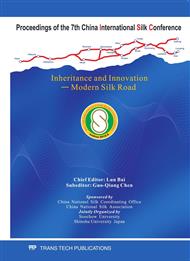p.3
p.8
p.13
p.19
p.25
p.30
p.36
p.41
Cloning and Expression Analysis of Acetylcholinesterase Gene (Bm-ace1, Bm-ace2) from Domesticated Silkworm, Bombyx mori
Abstract:
Acetylcholinesterase (AChE, 2 EC 3.1.1.7), encoded by the ace gene, catalyzes the hydrolysis of the neurotransmitter acetylcholine to terminate nerve impulses at the postsynaptic membrane. In this study, AChE genes (Bm-ace1, Bm-ace2) were cloned from domesticated silkworm Bombyx mori (Dazao strain) through RT-PCR. Sequence analysis showed that the ORF of Bm-ace1 gene contained 2 025 bp nucleotides, encoding 683 amino acid residues. The predicted protein has a molecular weight (MW) of 76.96 kD and an isoelectric point (pI) of 6.36; The ORF of Bm-ace2 gene contained 1 917 bp nucleotides, encoding 638 AA’s. The predicted protein has a MW of 71.68 kD and a pI of 5.49. These two acetylcholinesterase genes both contain conserved motifs including a catalytic triad, a choline-binding site and an acyl picket. A clustering analysis showed that Bm-ace1 (ABY50088)shared highest similarity with Bmm-ace1 (ABM66370) from Chinese wild silkworm (B. mandarina), Bm-ace2 (ABY50089) shared highest similarity with Bm-ace2 (NP_001037366) from B. mori. Using semi-quantitative RT-PCR, expression analyses in insect tissues and in development period demonstrated that Bm-ace1and Bm-ace2 were expressed highly in head and fat bodies; Bm-ace1 and Bm-ace2 were expressed firstly higher, then lower and higher again from 1st instar to 5th instar stages. Bm-ace1 was expressed higher than that of Bm-ace2 in all the stages. This result will help understanding of the resistance mechanism of B. mori to organophosphosphorous insecticides.
Info:
Periodical:
Pages:
13-18
Citation:
Online since:
January 2011
Authors:
Keywords:
Price:
Сopyright:
© 2011 Trans Tech Publications Ltd. All Rights Reserved
Share:
Citation:


